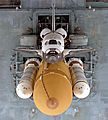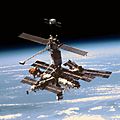STS-79 facts for kids
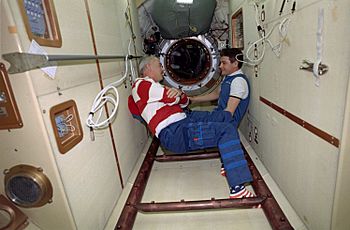
STS-79 commander Readdy (left) and Mir EO-22 commander Korzun (right) in Mir's Docking Module
|
|
| Mission type | Shuttle-Mir |
|---|---|
| Operator | NASA |
| Mission duration | 10 days, 3 hours, 19 minutes, 28 seconds |
| Distance travelled | 6,300,000 kilometres (3,900,000 mi) |
| Orbits completed | 160 |
| Spacecraft properties | |
| Spacecraft | Space Shuttle Atlantis |
| Crew | |
| Crew size | 6 |
| Members |
|
| Launching |
|
| Landing | |
| Start of mission | |
| Launch date | 16 September 1996, 08:54:49.048 UTC |
| Launch site | Kennedy LC-39A |
| End of mission | |
| Landing date | 26 September 1996, 12:13:20 UTC |
| Landing site | Kennedy SLF Runway 15 |
| Orbital parameters | |
| Reference system | Geocentric |
| Regime | Low Earth |
| Perigee | 368 kilometres (229 mi) |
| Apogee | 386 kilometres (240 mi) |
| Inclination | 51.7 degrees |
| Period | 92.1 min |
| Docking with Mir | |
| Docking port | SO starboard |
| Docking date | 19 September 1996, 03:13:18 UTC |
| Undocking date | 24 September 1996, 01:31:34 UTC |
| Time docked | 4 days, 22 hours, 18 minutes 16 seconds |
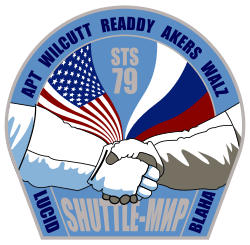 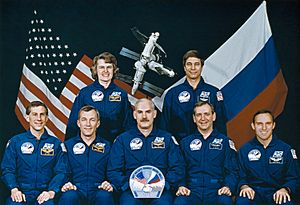 Left to right - Seated: Apt, Wilcutt, Readdy, Akers, Walz; Standing: Lucid, Blaha |
|
STS-79 was an important space mission. It was the 17th flight for the Space Shuttle Atlantis. It was also the 79th mission in the whole Space Shuttle program. During this trip, Atlantis flew to the Russian space station called Mir. The shuttle docked with Mir to deliver important equipment and supplies. It also brought new crew members and picked up others.
The crew on Atlantis also did many science experiments. This mission was special because it was the first time a shuttle met with a fully built Mir station. It was the fourth time a shuttle had docked with Mir.
Contents
Meet the Crew of STS-79
The STS-79 mission had a team of six astronauts. Each person had a very important job.
- Commander: William F. Readdy was in charge of the mission. This was his third and final space flight.
- Pilot: Terrence W. Wilcutt helped the commander fly the shuttle. This was his second flight.
- Mission Specialist 1: Jay Apt worked on many tasks and experiments. This was his fourth and last flight.
- Mission Specialist 2: Thomas D. Akers also helped with mission tasks. This was his fourth and last flight.
- Mission Specialist 3: Carl E. Walz was another key member of the team. This was his third flight.
- Mission Specialist 4: John E. Blaha flew up to Mir on this mission. He stayed on Mir for about four months. This was his fifth and last flight.
- Returning from Mir: Shannon Lucid came back to Earth on this mission. She had been living on Mir for a long time. This was her fifth and last flight.
Key Moments of the Mission
STS-79 was a very exciting mission with many important events.
First Docking with a Complete Mir
This mission was the first time a Space Shuttle docked with the Mir space station after it was fully built. This meant all of Mir's main parts, including the Priroda module, were in place. Atlantis carried a special part called the Orbiter Docking System. This system weighed about 1,821 kilograms (4,015 pounds).
Astronaut Exchange and Records
A major part of STS-79 was picking up American astronaut Shannon Lucid. She had been in space for 188 days! This set a new American record for the longest time in space. It was also a world record for a woman astronaut. Shannon Lucid had gone to Mir on the STS-76 mission.
After Shannon Lucid left Mir, astronaut John Blaha took her place. He stayed on Mir for about four months. He returned to Earth in January 1997 on the STS-81 mission. This was the first time American astronauts swapped places on the Russian Mir space station.
SPACEHAB Module and Supplies
STS-79 also carried a special module called SPACEHAB. This was the second time SPACEHAB was used to help with a Shuttle-Mir docking. For this mission, they used a new "Double Module" version.
The front part of the SPACEHAB module held experiments. The astronauts worked on these experiments before, during, and after Atlantis was docked to Mir. The back part of the module held all the supplies for Mir. This included food, clothes, and spare parts. The SPACEHAB module itself weighed 4,774 kilograms (10,525 pounds).
Docking and Transfers
The Space Shuttle Atlantis linked up with Mir on September 18, 1996, at 3:13 AM UTC. The hatches between the two spacecraft opened on September 19 at 5:40 AM. John Blaha and Shannon Lucid officially swapped places at 11:00 AM.
During the five days that Atlantis was docked to Mir, the two crews moved a lot of items. They transferred over 1,814 kilograms (4,000 pounds) of supplies to Mir. This included food, water, and other important items. They also moved three special experiments to Mir:
- The Biotechnology System (BTS) to study how cartilage develops.
- The Material in Devices as Superconductors (MIDAS) experiment to check how well certain materials conduct electricity.
- The Commercial Generic Bioprocessing Apparatus (CGBA), which held several smaller experiments, including ones about aquatic systems.
The astronauts also moved about 907 kilograms (2,000 pounds) of experiment samples and equipment from Mir back to Atlantis. In total, they moved over 2,722 kilograms (6,000 pounds) of items. This was the largest transfer of supplies between a shuttle and Mir up to that point.
Science on Mir and Atlantis
While Shannon Lucid was on Mir for six months, she did a lot of research. Her studies covered many areas, including:
- Advanced technology
- Earth sciences
- Biology
- Human health in space
- Microgravity research (how things behave in very low gravity)
- Space sciences
Some specific experiments included:
- Measuring radiation levels on Mir.
- Studying how dwarf wheat plants grew in space.
- Collecting blood and saliva to see how long-term spaceflight affects the human immune system.
Some of this research happened in Mir's newest module, Priroda.
Three experiments stayed on Atlantis:
- The Extreme Temperature Translation Furnace (ETTF), a new type of oven for processing materials in space at very high temperatures.
- The Commercial Protein Crystal Growth (CPCG) experiment, which grew crystals from 12 different proteins.
- The Mechanics of Granular Materials, which helped scientists understand how loose materials like sand behave. This could help us understand earthquakes better.
Preparing for the International Space Station
Like all Shuttle-Mir flights, STS-79 also helped prepare for the International Space Station (ISS). They tested new equipment to reduce risks for the ISS. One new experiment was the Active Rack Isolation System (ARIS). This system was designed to protect experiments from vibrations and shaking.
Near the end of the mission, Atlantis used its small jets to slightly lower its orbit. This was a test for future missions.
Images for kids
-
The Mir space station as seen when Atlantis undocked.


